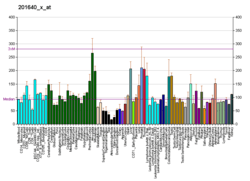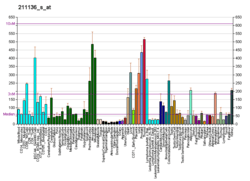Cleft lip and palate transmembrane protein 1 is a protein that in humans is encoded by the CLPTM1 gene.[5][6] It belongs to a family of several eukaryotic cleft lip and palate transmembrane protein 1 sequences.
Cleft lip with or without cleft palate is a common birth defect that is genetically complex. The nonsyndromic forms have been studied genetically using linkage and candidate-gene association studies with only partial success in defining the loci responsible for orofacial clefting. CLPTM1 encodes a transmembrane protein and has strong homology to two Caenorhabditis elegans genes, suggesting that CLPTM1 may belong to a new gene family.[7] This family also contains the Homo sapiens cisplatin resistance related protein CRR9p which is associated with CDDP-induced apoptosis.[8]
References
- 1 2 3 GRCh38: Ensembl release 89: ENSG00000104853 - Ensembl, May 2017
- 1 2 3 GRCm38: Ensembl release 89: ENSMUSG00000002981 - Ensembl, May 2017
- ↑ "Human PubMed Reference:".
- ↑ "Mouse PubMed Reference:".
- ↑ Yoshiura K, Machida J, Daack-Hirsch S, Patil SR, Ashworth LK, Hecht JT, Murray JC (Jan 1999). "Characterization of a novel gene disrupted by a balanced chromosomal translocation t(2;19)(q11.2;q13.3) in a family with cleft lip and palate". Genomics. 54 (2): 231–40. doi:10.1006/geno.1998.5577. PMID 9828125.
- ↑ "Entrez Gene: CLPTM1 cleft lip and palate associated transmembrane protein 1".
- ↑ Murray JC, Yoshiura K, Machida J, Daack-hirsch S, Patil SR, Ashworth LK, Hecht JT (1998). "Characterization of a novel gene disrupted by a balanced chromosomal translocation t(2;19)(q11.2;q13.3) in a family with cleft lip and palate". Genomics. 54 (2): 231–240. doi:10.1006/geno.1998.5577. PMID 9828125.
- ↑ Yamamoto K, Okamoto A, Isonishi S, Ochiai K, Ohtake Y (2001). "A novel gene, CRR9, which was up-regulated in CDDP-resistant ovarian tumor cell line, was associated with apoptosis". Biochem. Biophys. Res. Commun. 280 (4): 1148–1154. doi:10.1006/bbrc.2001.4250. PMID 11162647.
Further reading
- Maruyama K, Sugano S (1994). "Oligo-capping: a simple method to replace the cap structure of eukaryotic mRNAs with oligoribonucleotides". Gene. 138 (1–2): 171–4. doi:10.1016/0378-1119(94)90802-8. PMID 8125298.
- Takeuchi T, Kuro-o M, Miyazawa H, et al. (1997). "Transgenic expression of a novel thymic epithelial cell antigen stimulates aberrant development of thymocytes". J. Immunol. 159 (2): 726–33. PMID 9218588.
- Suzuki Y, Yoshitomo-Nakagawa K, Maruyama K, et al. (1997). "Construction and characterization of a full length-enriched and a 5'-end-enriched cDNA library". Gene. 200 (1–2): 149–56. doi:10.1016/S0378-1119(97)00411-3. PMID 9373149.
- Strausberg RL, Feingold EA, Grouse LH, et al. (2003). "Generation and initial analysis of more than 15,000 full-length human and mouse cDNA sequences". Proc. Natl. Acad. Sci. U.S.A. 99 (26): 16899–903. doi:10.1073/pnas.242603899. PMC 139241. PMID 12477932.
- Gerhard DS, Wagner L, Feingold EA, et al. (2004). "The status, quality, and expansion of the NIH full-length cDNA project: the Mammalian Gene Collection (MGC)". Genome Res. 14 (10B): 2121–7. doi:10.1101/gr.2596504. PMC 528928. PMID 15489334.
- Rossi MR, Hawthorn L, Platt J, et al. (2005). "Identification of inactivating mutations in the JAK1, SYNJ2, and CLPTM1 genes in prostate cancer cells using inhibition of nonsense-mediated decay and microarray analysis". Cancer Genet. Cytogenet. 161 (2): 97–103. doi:10.1016/j.cancergencyto.2005.02.006. PMID 16102578.
- Lewandrowski U, Moebius J, Walter U, Sickmann A (2006). "Elucidation of N-glycosylation sites on human platelet proteins: a glycoproteomic approach". Mol. Cell. Proteomics. 5 (2): 226–33. doi:10.1074/mcp.M500324-MCP200. PMID 16263699.
- Otsuki T, Ota T, Nishikawa T, et al. (2007). "Signal sequence and keyword trap in silico for selection of full-length human cDNAs encoding secretion or membrane proteins from oligo-capped cDNA libraries". DNA Res. 12 (2): 117–26. doi:10.1093/dnares/12.2.117. PMID 16303743.





